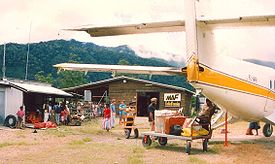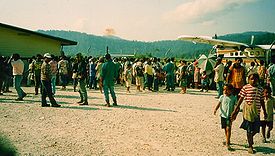
Mission Aviation Fellowship
Encyclopedia


Christian
A Christian is a person who adheres to Christianity, an Abrahamic, monotheistic religion based on the life and teachings of Jesus of Nazareth as recorded in the Canonical gospels and the letters of the New Testament...
organization that provides aviation, communications, and learning technology services to more than 1,000 Christian and humanitarian agencies, as well as thousands of isolated missionaries and indigenous villagers in the world's most remote areas. There are three major operational centers - Nampa, Idaho
Nampa, Idaho
Nampa is the largest and the fastest growing city in Canyon County, Idaho, USA. The population of Nampa was 81,557 at the 2010 census. Nampa is located about west of Boise along Interstate 84, and six miles west of Meridian. Nampa is part of the Boise metropolitan area...
, USA, Ashford
Ashford
Ashford is a relatively common English placename: it goes back to Old English æscet, indicating a ford near a clump of ash trees. It may refer to:-Places:In Australia:*Ashford, New South Wales*Ashford, South Australia...
, United Kingdom, and Cairns, Australia. These centers provide operational support to programs in the Americas, Africa and Asia Pacific regions. In 2010, MAF served in more than 55 countries, flying 201,710 passengers with a fleet of some 130 aircraft.
History
MAF began with several WWII pilots who had a vision for how aviation could be used to spread the Gospel. After WWII, Jim Truxton of the U.S., Murray Kendon in the United Kingdom, and Edwin Hartwig of Australia, with the support of like-minded Christians, founded missionary aviation agencies in their respective countries.The U.S. organization was the first to take to the air, under the name Christian Airmen’s Missionary Fellowship (CAMF), later known as Mission Aviation Fellowship (MAF). In 1946, pilot Betty Greene flew the first MAF plane on its inaugural flight, transporting two missionaries from Wycliffe Bible Translators to a remote jungle location in Mexico. In addition to Truxton and Greene, other early members of CAMF include Charlie Mellis, Nate Saint
Nate Saint
Nathanael "Nate" Saint was an evangelical Christian missionary pilot to Ecuador who, along with four others, was killed while attempting to evangelize the Waodani people through efforts known as Operation Auca....
, Larry Montgomery, Grady Parrott, George Fisk, Clarence Soderberg, and Jim Buyers. The earliest MAF fields of service were Mexico, Peru, and Ecuador. Over the years, the organization expanded to serve many countries of Africa, Latin America, Asia, and Eurasia.
In the U.K., Missionary Aviation Fellowship was initially organized as a wing of the Mildmay Movement (a Christian outreach organization), though it later became an independent organization. Murray Kendon was instrumental in the agency’s founding, as were Jack Hemmings, Stuart King, and Tom Banham. MAF-UK conducted a survey of Central Africa in 1948, followed by service in Sudan in 1950. In subsequent years, the U.K. organization expanded service to other African countries.
The organizational meeting for an Australian MAF (AMAF) organization was held on June 30, 1947. Early members included Edwin “Harry” Hartwig, Leonard Buck, John Nimmo, Bruce Morton and Ken Cooper. After the purchase of a de Havilland “Tiger Moth” aircraft in 1949, Hartwig and Alex Friend undertook a survey of northern Australia. Hartwig then completed a needs assessment survey in New Guinea. In 1951 Hartwig, along with Bob and Betty Hutchins of MAF-US, established service in New Guinea, based at Madang. On August 6, 1951, Hartwig was killed when his aircraft crashed in the Asaroka Pass in the Central Highlands. In the years following, work in Papua New Guinea and Dutch New Guinea (later called Irian Jaya, now Papua, Indonesia) continued through the joint efforts of the Australian and U.S. MAF organizations. Later, AMAF established service in central and north Australia (Arnhem Land), Borneo, and Bougainville.
MAF came to worldwide attention when, in 1956, MAF-US pilot Nate Saint
Nate Saint
Nathanael "Nate" Saint was an evangelical Christian missionary pilot to Ecuador who, along with four others, was killed while attempting to evangelize the Waodani people through efforts known as Operation Auca....
and four other missionaries were martyred on a beach in Ecuador by Auca Indians. Family members of those martyred returned to Ecuador and ministered to the tribe, and some of the men who killed the missionaries eventually turned to Christ. The story was featured in Life magazine, and several feature films have been made about the life and death of these missionaries, including End of the Spear in 2005.
In later years, MAF agencies were established in other countries, including New Zealand, South Africa, Finland, the Netherlands, Sweden, Norway, Denmark, Brazil, Mexico, and Canada.
MAF Learning Technologies (MAF LT) developed in a similar way to the aviation support. MAF staff saw the needs of isolated church leaders which could be met with the use of various educational technologies including the internet, computers, MP3 players and other communication devices. MAF Learning Technologies is providing support to many other ministries seeking to provide leadership training, education and community development training to people in isolated areas.
Areas of Service
Since its early days as an aviation ministry, MAF has grown and evolved to meet the changing needs of the isolated and impoverished people it serves. Though the airplane remains its primary ministry tool, MAF has emerged as the key provider of communications, learning technology, and logistics services in the world’s most remote areas. MAF missionaries perform tasks as diverse as digging wells in Mali, providing disaster relief services in Sumatra, installing jungle communications and internet wifi networks in Papua New Guinea and Ecuador, operating computer centers in rural African villages, providing air ambulance services in East Timor and Haiti, and showing the “JESUS” film in remote villages. Its learning technologies division provides training and biblical resources for thousands of isolated pastors and church leaders. The organization focuses its mission work in the areas of 1) evangelism and church nurture, 2) medical assistance, 3) disaster response, 4) community development, and 5) training and development of indigenous people.MAF has become well-known as a provider of disaster response and relief services. Following the 2004 tsunami which struck Sumatra on December 26, 2004, MAF provided air and communications support to humanitarian agencies responding to the crisis. In 2007, MAF provided aid following Cyclone Sidr in Bangladesh and Hurricane Felix in Nicaragua, and worked with the World Health Organization and Centers for Disease Control and Prevention to halt an Ebola outbreak in the Democratic Republic of Congo. In 2008, MAF planes evacuated missionaries and foreign aid workers from Chad following violence there. That same year, MAF airdropped food and medical supplies to villagers stranded by flooding in the wake of four deadly storms in Haiti, and served refugee camps in the Democratic Republic of Congo following clashes between government and rebel forces. Currently, MAF is providing relief services in response to the January 2010 earthquake in Haiti. (More information about MAF-Haiti here)
MAF also provides internet, I.T. and RF communications to its various projects around the globe. In disasters, MAF uses a mobile VSAT terminal which can be 'checked' onto most commercial airlines as baggage. This terminal can provide emergency communications anywhere in the world and can be quickly deployed. MAF's technology services played a critical role in the infrastructure and emergency aid to Indonesia's devastating tsunami. They have been providing aviation and communications support to remote parts of Indonesia for decades.


Crisis in the Democratic Republic of Congo
Mission Aviation Fellowship is maintaining flights for civilians and aid agencies in two of the Democratic Republic of Congo's current trouble spots. The latest fighting around the eastern town of Goma between government militia and rebel forces has displaced an estimated 250,000 people who are being forced back and forth between villages in some confusion. MAF pilots are flying medical supplies and medical staff to GomaGoma
Goma is a city in the eastern Democratic Republic of the Congo, on the northern shore of Lake Kivu, next to the Rwandan city of Gisenyi. The lake and the two cities are in the western branch of the Great Rift Valley, and Goma lies only 13 to 18 km due south of the crater of the active...
. Relief flights would have increased had it not been for a relatively open road network permitting delivery of aid by trucks. Despite recent staff evacuations and looting of personal belongings, MAF has been able to maintain or resume work in and around the eastern DRC towns of Goma
Goma
Goma is a city in the eastern Democratic Republic of the Congo, on the northern shore of Lake Kivu, next to the Rwandan city of Gisenyi. The lake and the two cities are in the western branch of the Great Rift Valley, and Goma lies only 13 to 18 km due south of the crater of the active...
, Bunia
Bunia
Bunia is a city in Democratic Republic of the Congo and is the headquarters of Ituri Interim Administration in the Ituri region of Orientale Province....
and Nyankunde.
Accidents
Roger Young, in his account of MAF operations in Papua New Guinea, documents the disappearance of MAF Cessna 185 registration VH-MFG on 23rd June 1967. Pilot John Harverson was on a routine short-hop (20 - 25 minute) flight from TelefominTelefomin
Telefomin is a station town on the border of Sandaun and Western Provinces in Papua New Guinea. The town started during the Second World War after Mick Leahy was assigned to engineer an air-strip in 1944 for the United States for use against the Imperial Japanese Army forces based in New Guinea.The...
to Olsobip
Olsobip
Olsobip is a station town in the north of the Papua New Guinean Western province, located on the Upper Fly River. It is the seat of the Olsobip Rural LLG. It has a rural airport but, set in a rich forest, it is unaccessable by road...
with two passengers when he was reported overdue after failing to radio in as scheduled. The flight involved a climb from 5500 feet (1676m) to over 9000 feet (2743m) to cross mountainous terrain, frequently shrouded in cloud, at the southern end of which is a sheer rock formation several thousand feet in height called the Hindenburg Wall. Despite an extensive 10-day search over 8000 square kilometres, neither the plane nor the bodies of the pilot and passengers were ever found. Some years later, an army helicopter pilot in the area reported seeing wreckage of an aircraft at the base of the Wall while overflying the area. Despite returning the following day, he was unable to re-locate the spot where the supposed wreckage had been glimpsed 24 hours earlier .
On 17 December 1994 a de Havilland Canada DHC-6 Twin Otter
De Havilland Canada DHC-6 Twin Otter
The DHC-6 Twin Otter is a Canadian 19-passenger STOL utility aircraft developed by de Havilland Canada and currently produced by Viking Air. The aircraft's fixed tricycle undercarriage, STOL abilities and high rate of climb have made it a successful cargo, regional passenger airliner and MEDEVAC...
200 with registration P2-MFS, operated by the Mission Aviation Fellowship crashed in Papua New Guinea
Papua New Guinea
Papua New Guinea , officially the Independent State of Papua New Guinea, is a country in Oceania, occupying the eastern half of the island of New Guinea and numerous offshore islands...
while en route from Tabubil
Tabubil
Tabubil is a planned, company operated township located in the Star Mountains area of the North Fly District of Western Province, Papua New Guinea...
to the nearby village of Selbang. 28 people were killed, including both the crew and all passengers. The aircraft struck a mountain due to poor visibility and lack of functioning instruments at 6400 ft.
On 22 February 2005, a de Havilland Canada DHC-6 Twin Otter
De Havilland Canada DHC-6 Twin Otter
The DHC-6 Twin Otter is a Canadian 19-passenger STOL utility aircraft developed by de Havilland Canada and currently produced by Viking Air. The aircraft's fixed tricycle undercarriage, STOL abilities and high rate of climb have made it a successful cargo, regional passenger airliner and MEDEVAC...
300 with registration P2-MFQ, operated by the Mission Aviation Fellowship crashed en route from Tabubil
Tabubil
Tabubil is a planned, company operated township located in the Star Mountains area of the North Fly District of Western Province, Papua New Guinea...
to Bimin. The plane hit a mountain whilst trying to detect the village runway. The two pilots, Chris Hansen, 37, and Richard West, 40 (both from New Zealand), were killed in the accident but the cabin attendant and 8 passengers survived and were able to walk to the village.
On 23 March 2006 a Cessna 206 aircraft operated by Missionary Aviation Fellowship crashed close to Tari, killing its pilot and injuring 3 passengers. The pilot was a 42 year Swiss man who had been in PNG with the Swiss Mission for 12 years, and left a wife and four children behind. The pilot had reportedly entered the circuit area around Tari
Tari
Tari might refer to:*Tari, Papua New Guinea, a Town in the Southern Highlands Province of Papua New Guinea, home to the world famous Huli...
airfield and appeared to be flying well, but never made it to the runway. The three passengers were PNG nationals.
On 16 October 2008, 23 year-old MAF Pilot Hadleigh Smith was killed while flying his GA8 aircraft (registration VH-WRT) to several Australian Aboriginal
Indigenous Australians
Indigenous Australians are the original inhabitants of the Australian continent and nearby islands. The Aboriginal Indigenous Australians migrated from the Indian continent around 75,000 to 100,000 years ago....
communities in Arnhem Land
Arnhem Land
The Arnhem Land Region is one of the five regions of the Northern Territory of Australia. It is located in the north-eastern corner of the territory and is around 500 km from the territory capital Darwin. The region has an area of 97,000 km² which also covers the area of Kakadu National...
, Australia
Australia
Australia , officially the Commonwealth of Australia, is a country in the Southern Hemisphere comprising the mainland of the Australian continent, the island of Tasmania, and numerous smaller islands in the Indian and Pacific Oceans. It is the world's sixth-largest country by total area...
.
Aviation
Mission Aviation Fellowship provides transport services to missionaries, translators, support personnel, consultants, trainers and linguists; provides medical evacuations; and assists in disaster relief work. In some areas, support is also provided to many Christian mission organizations, hospitals, local people and governments. Since these services involve flying into steep, short, or otherwise difficult runways, Mission Aviation Fellowship provides its personnel with training in STOL and other specialised techniques.- Cessna 172Cessna 172The Cessna 172 Skyhawk is a four-seat, single-engine, high-wing fixed-wing aircraft. First flown in 1955 and still in production, more Cessna 172s have been built than any other aircraft.-Design and development:...
- Cessna 206
- Quest KodiakQuest Kodiak|-See also:-External links:* * *...
- Twin Otter
External links
- Mission Aviation Fellowship New Zealand website
- Mission Aviation Fellowship Bangladesh website
- Mission Aviation Fellowship East Timor website
- Mission Aviation Fellowship Australia website
- Mission Aviation Fellowship Cambodia website
- Mission Aviation Fellowship UK website
- Mission Aviation Fellowship USA website
- Mission Aviation Fellowship USA Recruiting Website
- Mission Aviation Fellowship USA Learning Technologies Website
- Mission Aviation Fellowship Europe website
- Mission Aviation Fellowship South Africa website
- Mission Aviation Fellowship Canada website
- "Bush Flying at its Pinnacle" in SWAviator
- Mission Aviation Fellowship Haiti website
- Mission Aviation Fellowship Uganda website
Video
- Wings Like Eagles (DVD), Christian Television Association (of the UK)
Twin Otter landing in Tekin, Papua New Guinea

